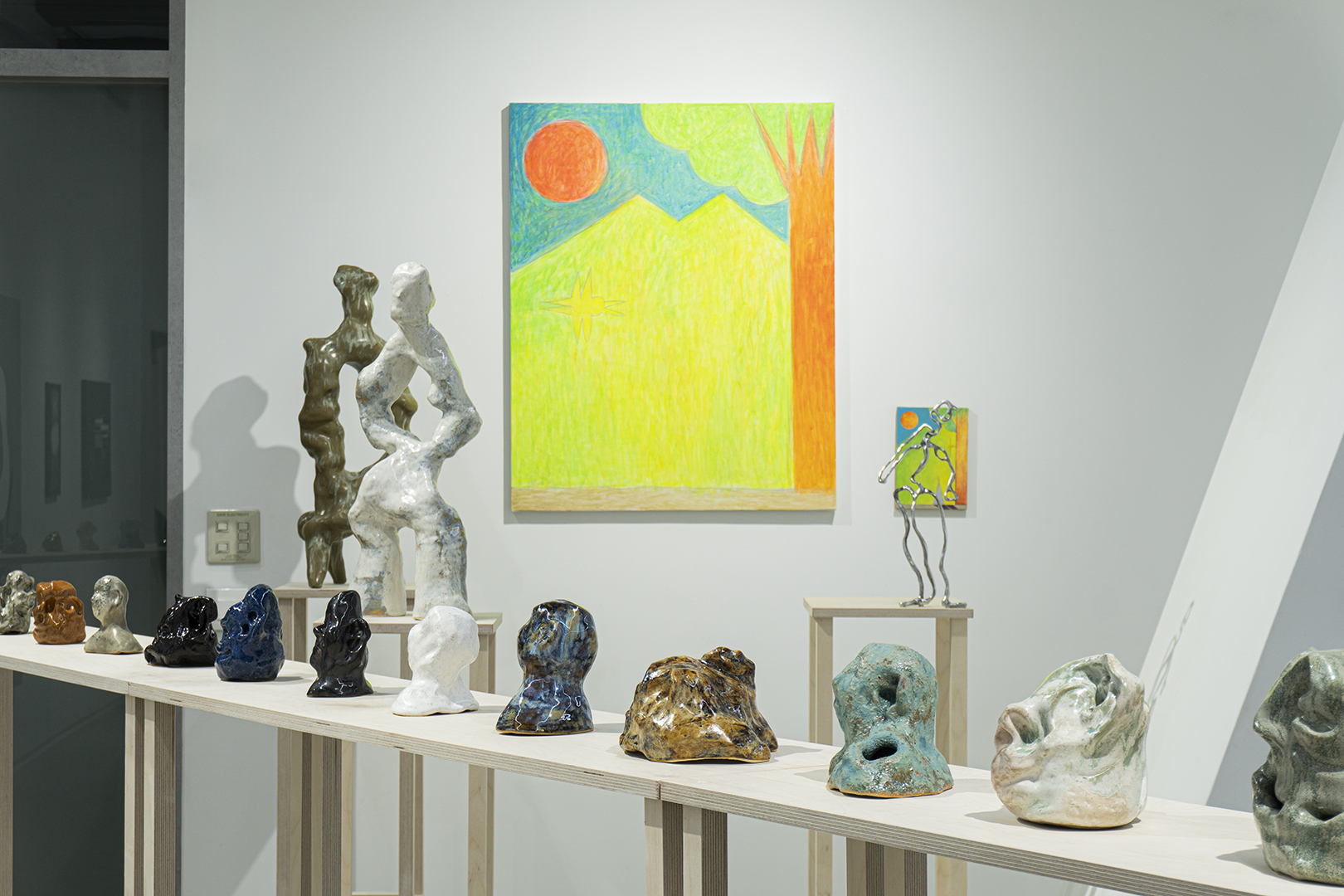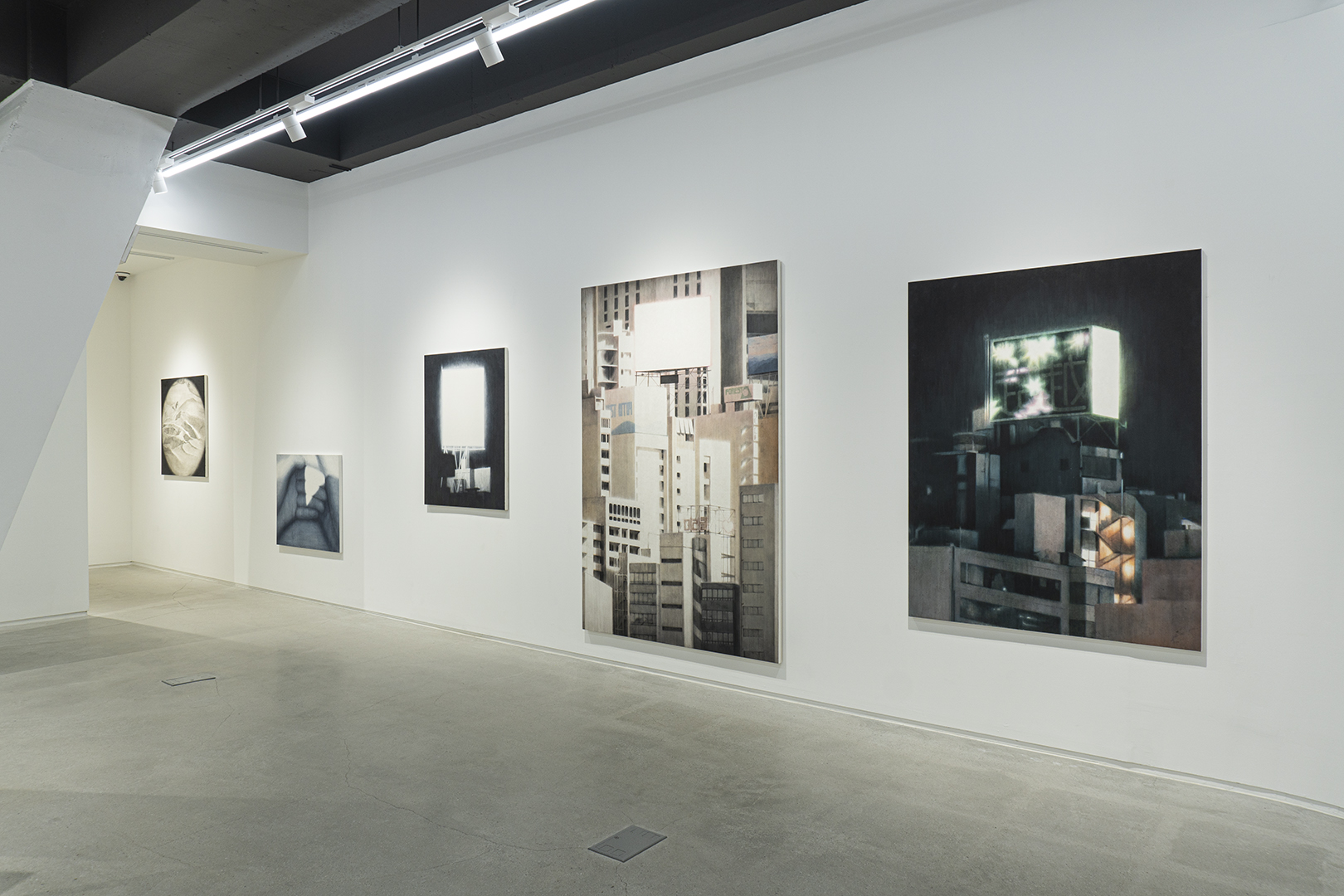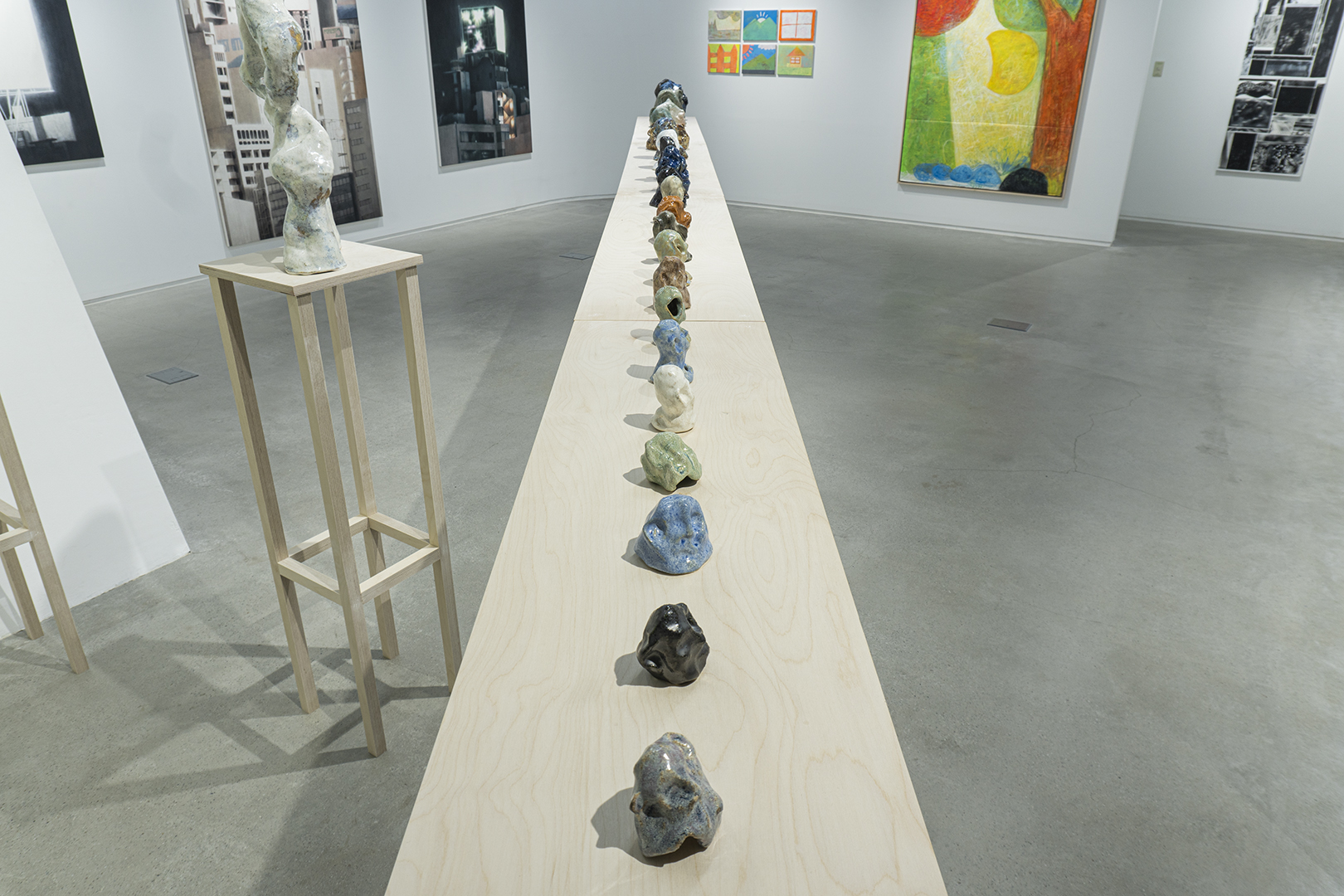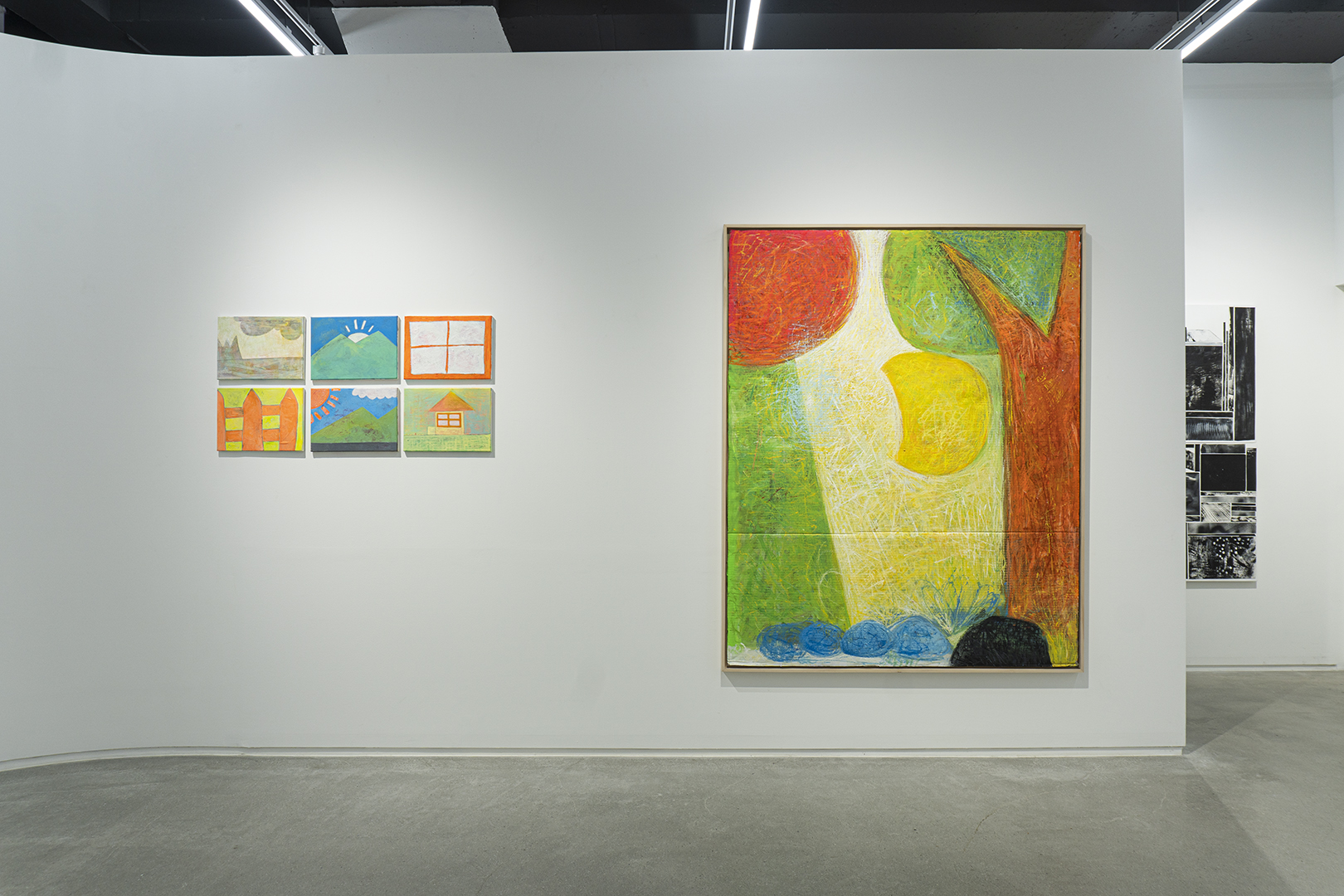Which working, nowadays
Soyeong Kim, Volo, Woochan Noh, Yonghyeon Lee
December 8, 2023 - January 6, 2024
Catalog / Press Released
CDA is pleasure to present 《Which working, nowadays》, an group exhibition with Soyeong Kim, Volo, Woochan Noh, and Yonghyeon Lee from December 8, 2023 to January 6, 2024. The exhibition aims to share a discourse on the contemporary art phenomenon metaphorized as 'nowadays' through the works of four talented emerging artists captured through collaborative programs held inside and outside the gallery throughout the year. The exhibition also aims to expand the viewer's perspective from the surface of the artwork, i.e. the image(screen), to the realm of the artwork, which includes the artist's actions and attitudes towards it.
Soyeong Kim, Volo, Woochan Noh, Yonghyeon Lee
December 8, 2023 - January 6, 2024
Catalog / Press Released
CDA is pleasure to present 《Which working, nowadays》, an group exhibition with Soyeong Kim, Volo, Woochan Noh, and Yonghyeon Lee from December 8, 2023 to January 6, 2024. The exhibition aims to share a discourse on the contemporary art phenomenon metaphorized as 'nowadays' through the works of four talented emerging artists captured through collaborative programs held inside and outside the gallery throughout the year. The exhibition also aims to expand the viewer's perspective from the surface of the artwork, i.e. the image(screen), to the realm of the artwork, which includes the artist's actions and attitudes towards it.
요즘, 어떤 작업
김소영, 노우찬, 우올로, 이용현
2023년 12월 8일 - 2024년 1월 6일
카탈로그 / 보도자료
씨디에이는 2023년 12월 8일부터 2024년 1월 6일까지 김소영, 노우찬, 우올로, 이용현 작가와 함께 꾸린 기획전 《요즘, 어떤 작업》을 선보인다. 이번 전시는 한 해 동안 갤러리 안팎에서 진행했던 연계 프로그램을 통해 포착된 네 명의 역량 있는 신진 작가들의 작품을 통해 ‘요즘’으로 은유한 동시대의 미술 현상에 대한 담론을 나누고자 하는 데에 의의가 있다. 더불어 전시를 관람하는 시야를 ‘작품’의 표면, 즉 이미지(화면)에서, 그것을 향한 작가의 행위와 태도를 아우르는 ‘작업’의 영역으로 확장하여 감상케 하는 것에도 목적을 두고 있다.
김소영, 노우찬, 우올로, 이용현
2023년 12월 8일 - 2024년 1월 6일
카탈로그 / 보도자료
씨디에이는 2023년 12월 8일부터 2024년 1월 6일까지 김소영, 노우찬, 우올로, 이용현 작가와 함께 꾸린 기획전 《요즘, 어떤 작업》을 선보인다. 이번 전시는 한 해 동안 갤러리 안팎에서 진행했던 연계 프로그램을 통해 포착된 네 명의 역량 있는 신진 작가들의 작품을 통해 ‘요즘’으로 은유한 동시대의 미술 현상에 대한 담론을 나누고자 하는 데에 의의가 있다. 더불어 전시를 관람하는 시야를 ‘작품’의 표면, 즉 이미지(화면)에서, 그것을 향한 작가의 행위와 태도를 아우르는 ‘작업’의 영역으로 확장하여 감상케 하는 것에도 목적을 두고 있다.










CDA presents 《Which working, nowadays》, a special exhibition with artists Soyeong Kim, Volo, Woochan Noh, and Yonghyeon Lee from December 8, 2023 to January 6, 2024. The exhibition aims to share a discourse on the contemporary art phenomenon metaphorized as 'nowadays' through the works of four talented emerging artists captured through collaborative programs held inside and outside the gallery throughout the year. The exhibition also aims to expand the viewer's perspective from the surface of the artwork, i.e. the image (screen), to the realm of the artwork, which encompasses the artist's actions and attitudes towards it.
'Nowadays', which is used to designate an object rather than to distinguish a range, is generally unfamiliar and esoteric regardless of the era. This is evidenced by the fact that "kids these days" are always a question mark, even for those of us who are relatively recent generations. It's one of the characteristics of the modern phenomenon that it appears quickly, becomes deeply colored, and then volatilizes as quickly as it refuses to get used to. If you try to write a trendy humor or meme, you're likely to be ridiculed for using it, and the moment you try to chase it, you'll find that another trendy thing has already been born. If there is no doubt that this is the nature of the current cultural and historical trends, which come like the wind and go away like dew, we need to understand 'these days' in dealing with the contemporary.
The selection of artists (works) for the exhibition to discourse on 'art of today' was based on two criteria. One is a biological criterion. The 2000s were still young, and the 1980s were a bit ambiguous. The exhibition consisted of artists born between 1997 and 1990. The other was the accessibility of the image (screen). I wanted work with a moderate familiarity, work that sits at that delicate nexus where the boundaries are not easily demarcated by association with a particular genre or style, but not so unfamiliar that it is difficult to think of objects of comparison and contrast. The exhibition literally takes the form of a jumble of these "some works" in the exhibition hall, forming a single plot.
This exhibition is also significant for communicating and analyzing the works of the four artists from the perspective of 'work'. If 'work' is the result, 'work' includes the process, the act, and the attitude toward it. From the perspective of painting, which emphasizes flatness, Soyeong Kim overlaps acrylic paint on a sheet of paper with numerous vertical lines of condensation, creating a hierarchy of materiality that creates depth and texture on the screen. Volo, on the other hand, embraces the texture-oriented expression and aesthetics of dots, lines, and planes found in abstract expressionism, synthesizing and reorganizing personal and social influences into visual elements to produce unique images. In order to convey a sense of reality, Woochan Noh sets as a condition of his work the painting itself, and for this purpose, he paints in primary colors, using geometric elements, such as the sun, mountains, and sky, as sculptural elements. He is also keen on presenting a depiction that focuses on the surface so that the painting can be seen as a painting. Yonghyeon Lee's work is driven by exploring and confronting the ambiguity of human emotions in a sculptural way to express the inner feelings of the unseen. Traces of Sensation is a series of works in which he uses the tactile sensation of his hands to sculpt a head, excluding vision, in order to sculpt the face of another person perceived through subjective sensibility. The work is characterized by an attempt to keep the invisible inner ambiguity as it is, without trying to reproduce or embody it in form.
Soyeong Kim and Volo's textures work differently on the canvas. The artificial, cold texture of acrylic, layered on top of the warmth of Zhang Ji, works in tandem with Kim's brushstrokes to create an ambivalent atmosphere on the canvas. Uolo, on the other hand, textures her canvases with the personal emotions that drive the narrative of her works. The pieces of canvas, which resemble hearts, are sculpted on a flat screen with their own textures. Yonghyun's sculptures are similar to Uhloe's in that they sense the unseen. Uhloe represents subjectivity, and Yonghyun represents ambiguity. Yonghyun focuses on the invisible, the ineffable, the indescribable. The artist says that in the process of perceiving an object, it can never be objective because each person's subjective emotions, knowledge, and experience inevitably act as a filter. Therefore, Yonghyun's work, which sculpts invisible objects with real materials, can be seen as the artist's sensory traces and distorted memories. On the other hand, Noochan paints to convey a sense of reality. He transfers what he actually sees to the screen, which sounds like a pun on the word real, but the painting itself is the only thing that exists in his work. In the process of researching how to make the paintings read as paintings, the artist takes cues from his childhood drawings, where he drew what he saw as he knew it. As a result, her canvases are composed of geometric and simple forms, and the viewer is naturally put in an environment where they can focus on the texture of the surface, the traces of the brush, and the layers of paint.
In this way, the works in Which working, nowadays relate to each other, each offering a new perspective from which to explore the work of the other artists. In total, 66 works are organically combined to form a single exhibition. They are both two-dimensional and three-dimensional, and include acrylics and oils, as well as gouache, pens, sprays, and a variety of other materials, drawn and applied on canvas, paper, and even cardboard. Using the most intuitive sensory organ, the hand, as a tool, Yonghyun's work is imbued with a natural acceptance of the fateful contingency of the medium (the transformation before and after being fired in the kiln). The works of the four artists are colorful in their attitudes, depending on the difference in medium, and it is recommended to compare their works with each other. Finally, we hope that their current works will give us a chance to infer the following works.
'Nowadays', which is used to designate an object rather than to distinguish a range, is generally unfamiliar and esoteric regardless of the era. This is evidenced by the fact that "kids these days" are always a question mark, even for those of us who are relatively recent generations. It's one of the characteristics of the modern phenomenon that it appears quickly, becomes deeply colored, and then volatilizes as quickly as it refuses to get used to. If you try to write a trendy humor or meme, you're likely to be ridiculed for using it, and the moment you try to chase it, you'll find that another trendy thing has already been born. If there is no doubt that this is the nature of the current cultural and historical trends, which come like the wind and go away like dew, we need to understand 'these days' in dealing with the contemporary.
The selection of artists (works) for the exhibition to discourse on 'art of today' was based on two criteria. One is a biological criterion. The 2000s were still young, and the 1980s were a bit ambiguous. The exhibition consisted of artists born between 1997 and 1990. The other was the accessibility of the image (screen). I wanted work with a moderate familiarity, work that sits at that delicate nexus where the boundaries are not easily demarcated by association with a particular genre or style, but not so unfamiliar that it is difficult to think of objects of comparison and contrast. The exhibition literally takes the form of a jumble of these "some works" in the exhibition hall, forming a single plot.
This exhibition is also significant for communicating and analyzing the works of the four artists from the perspective of 'work'. If 'work' is the result, 'work' includes the process, the act, and the attitude toward it. From the perspective of painting, which emphasizes flatness, Soyeong Kim overlaps acrylic paint on a sheet of paper with numerous vertical lines of condensation, creating a hierarchy of materiality that creates depth and texture on the screen. Volo, on the other hand, embraces the texture-oriented expression and aesthetics of dots, lines, and planes found in abstract expressionism, synthesizing and reorganizing personal and social influences into visual elements to produce unique images. In order to convey a sense of reality, Woochan Noh sets as a condition of his work the painting itself, and for this purpose, he paints in primary colors, using geometric elements, such as the sun, mountains, and sky, as sculptural elements. He is also keen on presenting a depiction that focuses on the surface so that the painting can be seen as a painting. Yonghyeon Lee's work is driven by exploring and confronting the ambiguity of human emotions in a sculptural way to express the inner feelings of the unseen. Traces of Sensation is a series of works in which he uses the tactile sensation of his hands to sculpt a head, excluding vision, in order to sculpt the face of another person perceived through subjective sensibility. The work is characterized by an attempt to keep the invisible inner ambiguity as it is, without trying to reproduce or embody it in form.
Soyeong Kim and Volo's textures work differently on the canvas. The artificial, cold texture of acrylic, layered on top of the warmth of Zhang Ji, works in tandem with Kim's brushstrokes to create an ambivalent atmosphere on the canvas. Uolo, on the other hand, textures her canvases with the personal emotions that drive the narrative of her works. The pieces of canvas, which resemble hearts, are sculpted on a flat screen with their own textures. Yonghyun's sculptures are similar to Uhloe's in that they sense the unseen. Uhloe represents subjectivity, and Yonghyun represents ambiguity. Yonghyun focuses on the invisible, the ineffable, the indescribable. The artist says that in the process of perceiving an object, it can never be objective because each person's subjective emotions, knowledge, and experience inevitably act as a filter. Therefore, Yonghyun's work, which sculpts invisible objects with real materials, can be seen as the artist's sensory traces and distorted memories. On the other hand, Noochan paints to convey a sense of reality. He transfers what he actually sees to the screen, which sounds like a pun on the word real, but the painting itself is the only thing that exists in his work. In the process of researching how to make the paintings read as paintings, the artist takes cues from his childhood drawings, where he drew what he saw as he knew it. As a result, her canvases are composed of geometric and simple forms, and the viewer is naturally put in an environment where they can focus on the texture of the surface, the traces of the brush, and the layers of paint.
In this way, the works in Which working, nowadays relate to each other, each offering a new perspective from which to explore the work of the other artists. In total, 66 works are organically combined to form a single exhibition. They are both two-dimensional and three-dimensional, and include acrylics and oils, as well as gouache, pens, sprays, and a variety of other materials, drawn and applied on canvas, paper, and even cardboard. Using the most intuitive sensory organ, the hand, as a tool, Yonghyun's work is imbued with a natural acceptance of the fateful contingency of the medium (the transformation before and after being fired in the kiln). The works of the four artists are colorful in their attitudes, depending on the difference in medium, and it is recommended to compare their works with each other. Finally, we hope that their current works will give us a chance to infer the following works.
씨디에이는 2023년 12월 8일부터 2024년 1월 6일까지 김소영, 노우찬, 우올로, 이용현 작가와
함께 꾸린 기획전 《요즘, 어떤 작업》을 선보인다. 이번 전시는 한 해 동안 갤러리 안팎에서 진행했던
연계 프로그램을 통해 포착된 네 명의 역량 있는 신진 작가들의 작품을 통해 ‘요즘’으로 은유한 동시대의 미술 현상에 대한 담론을 나누고자 하는
데에 의의가 있다. 더불어 전시를 관람하는 시야를 ‘작품’의 표면, 즉 이미지(화면)에서, 그것을 향한 작가의 행위와 태도를 아우르는 ‘작업’의
영역으로 확장하여 감상케 하는 것에도 목적을 두고 있다.
범위를 구분하는 용도가 아닌 대상을 특정하는 의미로 사용되는 ‘요즘’의 것은 시대를 불문하고 대체로 낯설고 난해하다. 비교적 요즘 세대로 구분되는 이들에게도 ‘요즘 애들’은 늘 물음표투성인 것이 이를 뒷받침한다. 빠르게 나타나서 짙게 물들었다가 익숙해지는 것을 거부라도 하듯 금세 휘발되는 것이 요즘이라는 현상이 가지는 특징 중 하나다. 유행한다는 유머나 밈(meme)을 써보려고 해도 요즘 누가 그걸 쓰냐며 놀림을 받는 형국에서, ‘요즘’을 좇으려 하는 순간 이미 또 다른 ‘요즘’의 것이 태동했음을 눈치챌 수 있다. 이처럼 바람처럼 왔다가 이슬처럼 가버리는 것이 바로 현재의 문화적, 시대적 흐름이 가지는 성격임이 틀림이 없다면, 우리는 동시대를 다룸에 있어 ‘요즘’을 이해할 필요가 있다.
‘요즘의 미술’을 담론하기 위한 전시의 작가(작업)를 선정하는 데에는 두 가지 기준이 기반이 되었다. 하나는 생물학적 기준이다. 2000년대는 아직 이르고, 1980년대는 살짝 애매했다. 이번 전시는 1997년부터 1990년까지 출생한 작가들로 구성되었다. 또 다른 하나는 바로 이미지(화면)의 접근성이다. 적당한 익숙함을 가진 작업이 필요했다. 특정 장르나 스타일로 유추되어 그 경계가 쉽게 구분되지 않으면서도 비교와 대조의 대상을 떠올리기 어려울 정도로 낯설지도 아니한, 그 미묘한 꼭짓점에 위치한 작업. 이번 전시는 말 그대로 이러한 ‘어떤 작업’들이 전시장에 뒤죽박죽 섞여 하나의 플롯을 이루는 형태를 띠고 있다.
이번 전시는 네 작가의 작품을 ‘작업’이라는 관점으로 소통하고 풀이하는 것에도 의의가 있다. ‘작품’이 결과라면 ‘작업’은 과정과 행위, 그리고 그것을 대하는 태도까지 모두 포함한다. 평면성이 강조되는 회화의 관점에서 김소영 작가는 장지에 아크릴 물감을 수직의 결로 수없이 중첩하며 물성의 층위를 만들어 화면의 깊이와 질감을 만든다. 한편, 우올로 작가는 추상표현주의에서 나타나는 질감 중심의 표현과 점, 선, 면의 조형이 갖는 미학을 받아들이면서 개인적, 사회적으로 영향을 받은 것들을 시각적 요소로 합성, 재구성해 독자적인 이미지를 생산한다. 노우찬 작가는 실재의 감각을 전달하기 위해 그림 그 자체를 그리는 것을 작업의 조건으로 설정하고 이를 위해 관념적이고 동시에 기하학적인 요소, 이를테면 해, 산, 하늘 등을 조형 요소로 활용하여 원색적으로 그림을 그린다. 또한, 그림이 그림으로 보일 수 있게 표면에 집중한 묘사를 선보이는 것에 열중한다.이용현 작가는 보이지 않는 인간의 내면적 감정을 표현하기 위해 그 모호함을 조형적으로 탐구하고 이를 마주하는 것을 작업의 원동력으로 삼는다. 〈감각의 흔적〉연작은 주관적인 감성을 통해 인식되는 타인의 얼굴을 조형화하기 위해 시각을 배제한 채 손의 촉각을 이용해 두상을 조형한 작업이다. 비가시적인 내면의 모호함을 형태로 재현하거나 구현하려 들지 않고 몽롱한 그대로 유지하려는 시도가 작업의 특징이다.
김소영과 우올로의 질감은 화면위에서 각각 다르게 작용한다. 장지 특유의 온화함 위로 쌓이는 아크릴의 인공적이면서 차가운 질감은 김소영의 붓질과 어우러져 화면의 양면적인 분위기를 만들어낸다. 반면 우올로는 작품의 서사를 견인하는 개인의 감정을 캔버스에 질감으로 입힌다. 마음을 닮은 캔버스 조각들은 저마다의 질감으로 평면의 화면 위에서 조형된다. 이용현 조형도 역시 보이지 않는 것을 감각하는 점에서 우올로의 그것과 유사성을 가진다. 우올로는 주체성을, 이용현은 모호함을 형상한다. 이용현은 눈에 보이지 않고 언어로 표현할 수 없는 몽롱함에 집중한다. 작가는 대상을 인식하는 과정에서 필연적으로 각자의 주관적인 감성이나 지식, 경험 등이 필터로 작용하기 때문에 결코 그것이 객관적일 수 없다고 말한다. 따라서 보이지 않는 대상을 실재하는 재료로 조각하는 이용현의 작업은 작가의 감각 흔적이자 왜곡된 기억에 가깝다고 볼 수 있다. 반대로 노우찬은 실재의 감각을 전달하기 위해 그린다. 실제로 보이는 대상을 화면에 옮긴다는 말인데, 그의 작업에 실재하는 것 말장난처럼 들리지만 그림 그 자체가 유일하다. 그림이 그림 자체로 읽히도록 하기 위한 연구의 과정에서 작가는 보이는 대상을 아는 대로 그렸던 유년 시절의 그림에서 힌트를 얻게 된다. 덕분에 작가의 화면은 기하학적이고 단순한 형태들로 구성되었고, 관람자는 자연스럽게 표면의 질감과 붓의 흔적, 그리고 층층이 쌓인 물감에 집중할 수 있는 환경에 놓이게 된다.
이처럼 《요즘, 어떤 작업 Which working, nowadays》의 출품작은 각각이 다른 작가의 작업을 탐색할 수 있는 새로운 관점을 제시해 주며 서로 관계를 맺는다. 총 66점의 작업이 유기적 결합을 이루며 하나의 전시를 구성하는 셈이다. 여기에는 평면과 입체가 모두 포함되어 있고, 아크릴과 유화를 필두로 과슈, 펜, 스프레이 등 다채로운 재료가 캔버스나 장지, 심지어 카드보드지(cardboard) 위에서 그려지고 부착되며 저마다의 역할을 수행한다. 손이라는 가장 직관적인 감각 기관을 도구로 사용하는 이용현의 작업에는 매체가 가지는 숙명적인 우연성(가마에 구워지기 전후의 변형)을 자연스럽게 받아들이는 태도 또한 고스란히 스며들어 있다. 네 작가의 작품은 매체의 차이에 따라 그 작업의 태도가 다채로운 양상을 띠고 있어 서로 비교하며 관람하기를 권한다. 마지막으로, 이들의 요즘 작업으로 짐작해 볼 수 있는 다음의 작업 또한 유추할 수 있는 기회가 되길 희망한다.
범위를 구분하는 용도가 아닌 대상을 특정하는 의미로 사용되는 ‘요즘’의 것은 시대를 불문하고 대체로 낯설고 난해하다. 비교적 요즘 세대로 구분되는 이들에게도 ‘요즘 애들’은 늘 물음표투성인 것이 이를 뒷받침한다. 빠르게 나타나서 짙게 물들었다가 익숙해지는 것을 거부라도 하듯 금세 휘발되는 것이 요즘이라는 현상이 가지는 특징 중 하나다. 유행한다는 유머나 밈(meme)을 써보려고 해도 요즘 누가 그걸 쓰냐며 놀림을 받는 형국에서, ‘요즘’을 좇으려 하는 순간 이미 또 다른 ‘요즘’의 것이 태동했음을 눈치챌 수 있다. 이처럼 바람처럼 왔다가 이슬처럼 가버리는 것이 바로 현재의 문화적, 시대적 흐름이 가지는 성격임이 틀림이 없다면, 우리는 동시대를 다룸에 있어 ‘요즘’을 이해할 필요가 있다.
‘요즘의 미술’을 담론하기 위한 전시의 작가(작업)를 선정하는 데에는 두 가지 기준이 기반이 되었다. 하나는 생물학적 기준이다. 2000년대는 아직 이르고, 1980년대는 살짝 애매했다. 이번 전시는 1997년부터 1990년까지 출생한 작가들로 구성되었다. 또 다른 하나는 바로 이미지(화면)의 접근성이다. 적당한 익숙함을 가진 작업이 필요했다. 특정 장르나 스타일로 유추되어 그 경계가 쉽게 구분되지 않으면서도 비교와 대조의 대상을 떠올리기 어려울 정도로 낯설지도 아니한, 그 미묘한 꼭짓점에 위치한 작업. 이번 전시는 말 그대로 이러한 ‘어떤 작업’들이 전시장에 뒤죽박죽 섞여 하나의 플롯을 이루는 형태를 띠고 있다.
이번 전시는 네 작가의 작품을 ‘작업’이라는 관점으로 소통하고 풀이하는 것에도 의의가 있다. ‘작품’이 결과라면 ‘작업’은 과정과 행위, 그리고 그것을 대하는 태도까지 모두 포함한다. 평면성이 강조되는 회화의 관점에서 김소영 작가는 장지에 아크릴 물감을 수직의 결로 수없이 중첩하며 물성의 층위를 만들어 화면의 깊이와 질감을 만든다. 한편, 우올로 작가는 추상표현주의에서 나타나는 질감 중심의 표현과 점, 선, 면의 조형이 갖는 미학을 받아들이면서 개인적, 사회적으로 영향을 받은 것들을 시각적 요소로 합성, 재구성해 독자적인 이미지를 생산한다. 노우찬 작가는 실재의 감각을 전달하기 위해 그림 그 자체를 그리는 것을 작업의 조건으로 설정하고 이를 위해 관념적이고 동시에 기하학적인 요소, 이를테면 해, 산, 하늘 등을 조형 요소로 활용하여 원색적으로 그림을 그린다. 또한, 그림이 그림으로 보일 수 있게 표면에 집중한 묘사를 선보이는 것에 열중한다.이용현 작가는 보이지 않는 인간의 내면적 감정을 표현하기 위해 그 모호함을 조형적으로 탐구하고 이를 마주하는 것을 작업의 원동력으로 삼는다. 〈감각의 흔적〉연작은 주관적인 감성을 통해 인식되는 타인의 얼굴을 조형화하기 위해 시각을 배제한 채 손의 촉각을 이용해 두상을 조형한 작업이다. 비가시적인 내면의 모호함을 형태로 재현하거나 구현하려 들지 않고 몽롱한 그대로 유지하려는 시도가 작업의 특징이다.
김소영과 우올로의 질감은 화면위에서 각각 다르게 작용한다. 장지 특유의 온화함 위로 쌓이는 아크릴의 인공적이면서 차가운 질감은 김소영의 붓질과 어우러져 화면의 양면적인 분위기를 만들어낸다. 반면 우올로는 작품의 서사를 견인하는 개인의 감정을 캔버스에 질감으로 입힌다. 마음을 닮은 캔버스 조각들은 저마다의 질감으로 평면의 화면 위에서 조형된다. 이용현 조형도 역시 보이지 않는 것을 감각하는 점에서 우올로의 그것과 유사성을 가진다. 우올로는 주체성을, 이용현은 모호함을 형상한다. 이용현은 눈에 보이지 않고 언어로 표현할 수 없는 몽롱함에 집중한다. 작가는 대상을 인식하는 과정에서 필연적으로 각자의 주관적인 감성이나 지식, 경험 등이 필터로 작용하기 때문에 결코 그것이 객관적일 수 없다고 말한다. 따라서 보이지 않는 대상을 실재하는 재료로 조각하는 이용현의 작업은 작가의 감각 흔적이자 왜곡된 기억에 가깝다고 볼 수 있다. 반대로 노우찬은 실재의 감각을 전달하기 위해 그린다. 실제로 보이는 대상을 화면에 옮긴다는 말인데, 그의 작업에 실재하는 것 말장난처럼 들리지만 그림 그 자체가 유일하다. 그림이 그림 자체로 읽히도록 하기 위한 연구의 과정에서 작가는 보이는 대상을 아는 대로 그렸던 유년 시절의 그림에서 힌트를 얻게 된다. 덕분에 작가의 화면은 기하학적이고 단순한 형태들로 구성되었고, 관람자는 자연스럽게 표면의 질감과 붓의 흔적, 그리고 층층이 쌓인 물감에 집중할 수 있는 환경에 놓이게 된다.
이처럼 《요즘, 어떤 작업 Which working, nowadays》의 출품작은 각각이 다른 작가의 작업을 탐색할 수 있는 새로운 관점을 제시해 주며 서로 관계를 맺는다. 총 66점의 작업이 유기적 결합을 이루며 하나의 전시를 구성하는 셈이다. 여기에는 평면과 입체가 모두 포함되어 있고, 아크릴과 유화를 필두로 과슈, 펜, 스프레이 등 다채로운 재료가 캔버스나 장지, 심지어 카드보드지(cardboard) 위에서 그려지고 부착되며 저마다의 역할을 수행한다. 손이라는 가장 직관적인 감각 기관을 도구로 사용하는 이용현의 작업에는 매체가 가지는 숙명적인 우연성(가마에 구워지기 전후의 변형)을 자연스럽게 받아들이는 태도 또한 고스란히 스며들어 있다. 네 작가의 작품은 매체의 차이에 따라 그 작업의 태도가 다채로운 양상을 띠고 있어 서로 비교하며 관람하기를 권한다. 마지막으로, 이들의 요즘 작업으로 짐작해 볼 수 있는 다음의 작업 또한 유추할 수 있는 기회가 되길 희망한다.